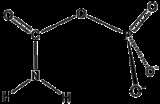
Carbamoyl phosphate
Encyclopedia
Carbamoyl phosphate is an anion of biochemical significance. In land-dwelling animals it is an intermediary metabolite participating in the nitrogen
disposal through in the urea cycle
and the synthesis of pyrimidine
s.
It is produced from bicarbonate
, ammonia
(derived from glutamate), and phosphate
(from ATP
). The synthesis is catalysed by the enzyme carbamoyl phosphate synthetase
, as follows:
Nitrogen
Nitrogen is a chemical element that has the symbol N, atomic number of 7 and atomic mass 14.00674 u. Elemental nitrogen is a colorless, odorless, tasteless, and mostly inert diatomic gas at standard conditions, constituting 78.08% by volume of Earth's atmosphere...
disposal through in the urea cycle
Urea cycle
The urea cycle is a cycle of biochemical reactions occurring in many animals that produces urea from ammonia . This cycle was the first metabolic cycle discovered , five years before the discovery of the TCA cycle...
and the synthesis of pyrimidine
Pyrimidine
Pyrimidine is a heterocyclic aromatic organic compound similar to benzene and pyridine, containing two nitrogen atoms at positions 1 and 3 of the six-member ring...
s.
It is produced from bicarbonate
Bicarbonate
In inorganic chemistry, bicarbonate is an intermediate form in the deprotonation of carbonic acid...
, ammonia
Ammonia
Ammonia is a compound of nitrogen and hydrogen with the formula . It is a colourless gas with a characteristic pungent odour. Ammonia contributes significantly to the nutritional needs of terrestrial organisms by serving as a precursor to food and fertilizers. Ammonia, either directly or...
(derived from glutamate), and phosphate
Phosphate
A phosphate, an inorganic chemical, is a salt of phosphoric acid. In organic chemistry, a phosphate, or organophosphate, is an ester of phosphoric acid. Organic phosphates are important in biochemistry and biogeochemistry or ecology. Inorganic phosphates are mined to obtain phosphorus for use in...
(from ATP
Adenosine triphosphate
Adenosine-5'-triphosphate is a multifunctional nucleoside triphosphate used in cells as a coenzyme. It is often called the "molecular unit of currency" of intracellular energy transfer. ATP transports chemical energy within cells for metabolism...
). The synthesis is catalysed by the enzyme carbamoyl phosphate synthetase
Carbamoyl phosphate synthetase
Carbamoyl phosphate synthetase catalyzes the ATP-dependent synthesisof carbamoyl phosphate from glutamine or ammonia and bicarbonate. This enzyme catalyzes the reaction of ATP and bicarbonate to produce carbonyl phosphate and ADP. Carbonyl phosphate reacts with ammonia to give carbamate...
, as follows:
- HCO3− + ATP → ADP + HO–C(O)–OPO32− (carboxyl phosphate)
- HO–C(O)–OPO32− + NH3 + OH− → HPO42− + −O–C(O)NH2CarbamateCarbamates are organic compounds derived from carbamic acid . A carbamate group, carbamate ester, and carbamic acids are functional groups that are inter-related structurally and often are interconverted chemically. Carbamate esters are also called urethanes.-Synthesis:Carbamic acids are derived...
+ H2O - −O–C(O)NH2 + ATP → ADP + H2NC(O)OPO32−

